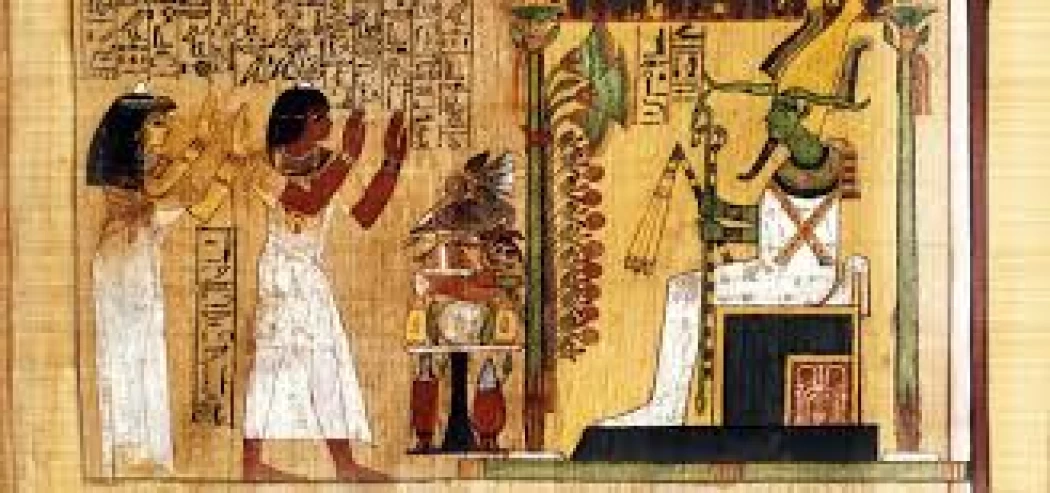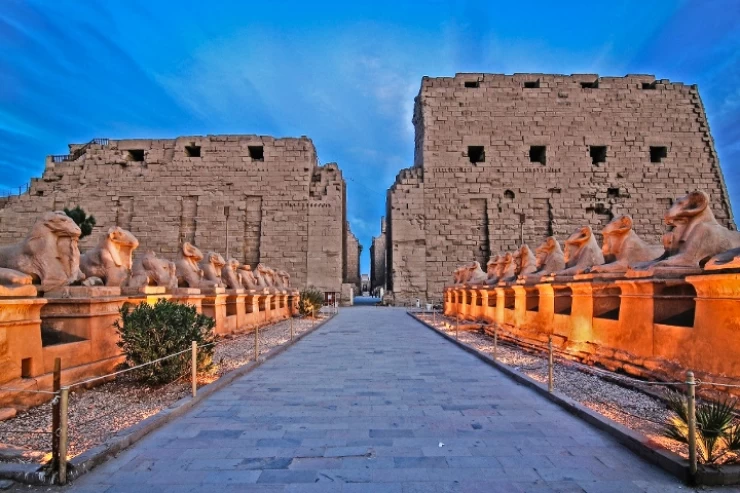
Il libro dei morti | Testo funerario egizio antico
All'interno si trovavano testi funerari di vario genere, sia formule magico-religiose che racconti, con l'aiuto dei quali il defunto poteva superare le innumerevoli prove che avrebbe dovuto affrontare sul lungo e tortuoso percorso che lo portava alla presenza di Osiride. I testi, quindi, lo avrebbero aiutato sia a raggiungere il dio della morte senza particolari problemi, sia a preparare la cosiddetta testimonianza della sua vita terrena, la cui prova apparteneva a Osiride.
Il Libro dei Morti ha assunto varie forme nel tempo. Inizialmente, infatti, formule e storie venivano incise sulle pareti della tomba, per poi essere incise direttamente sul sarcofago. Nel corso del tempo e fino alla XVIII dinastia (1543-1292 a.C.), il libro dei morti cambiò nuovamente forma: i testi funebri furono trasferiti su papiro, quindi chiusi in un sarcofago insieme al defunto e a tutti quegli oggetti che potevano essere utili nel suo ultimo viaggio.
Queste formule magiche poste nelle tombe, secondo le credenze, proteggevano e aiutavano i defunti negli inferi, e includono inni al dio Amon Re, il dio del sole. Possiamo vedere descrizioni di incantesimi sui passaggi e sulle pareti delle tombe, sugli involucri delle mummie e persino all'interno della maschera dorata del re Tutankhamon.
Il Libro dei Morti è apparso per la prima volta nel Nuovo Regno, ma il suo testo si è evoluto da una lunga storia di scrittura funebre magica. Il più antico di loro, i Testi delle Piramidi, erano accessibili solo agli egiziani. Poi si sono evoluti in Testi di bara - una versione modificata dei Testi delle Piramidi-che sono stati scritti su bare e inclusi nelle tombe di persone non reali, come ricchi egiziani e rappresentanti dell'élite.
Osiride era il dio della resurrezione, e Re era il dio del sole, una stella nel Libro dei Morti. Poi altri 42 dèi si rivolgono al giudice. Anche se il testo stesso varia nel contenuto e nell'ordine, la storia è solitamente divisa in quattro sezioni principali: il defunto entra negli inferi e riacquista i poteri fisici dei vivi, il defunto risorge e si unisce a Re per risorgere come il sole ogni giorno, viaggia attraverso il cielo prima del giudizio negli inferi degli dei e, infine, trova un'anima.
Pacchetti di viaggio in Egitto per visitare templi e piramidi egiziane e conoscere meglio la mitologia e le centinaia di dei adorati dai faraoni, che erano molto simili agli umani, che amavano e odiavano, provavano gelosia, combattevano e morivano durante un incredibile mito pieno di eventi gioiosi, attivi e drammatici che hanno ispirato registi e produttori moderni a creare film di fama mondiale sulla grandezza dei faraoni e degli dei che adoravano. Mettere da parte un paio di giorni per visitare Abydos, Giza, Luxor, Assuan per vedere le tombe dei faraoni decorate con scene molto chiare, dettagliate e splendidamente dipinte di varie divinità dell'Antico Egitto, così come molti altri luoghi, città, avventure e attività al Cairo, Si può provare e prenotare uno dei nostri tour in Egitto e pacchetti turistici Egitto molti gruppi privati con una guida Cairo day tours dall'aeroporto e Egitto day tours per esplorare la capitale dell'Egitto, Il Cairo È possibile controllare molti itinerari Egitto o andare su uno dei nostri tour di un giorno completo Cairo come:
- Itinerari turistici in Egitto / Itinerari in Egitto.
- Tour ad Assuan / Escursioni ad Assuan / Tour di un giorno ad Assuan / Visite guidate ad Assuan.
Inside were funerary texts of various kinds, both magico-religious formulas and stories, with the help of which the deceased could overcome the countless trials that he would face on the long and winding path that led him to the presence of Osiris. The texts, therefore, would have helped him both to reach the god of death without any special problems, and to prepare the so-called testimony of his earthly life, the trial of which belonged to Osiris.
The Book of the Dead has taken various forms over time. Initially, indeed, formulas and stories were engraved on the walls of the tomb, only to be engraved directly on the sarcophagus. Over time and until the eighteenth dynasty (1543-1292 BC), the book of the dead changed its form again: the funeral texts were transferred to papyrus, then closed in a sarcophagus along with the deceased and all those objects that could be useful in his last journey.
These magical formulas placed in tombs, according to beliefs, protected and helped the deceased in the underworld, and they include hymns to the god Amun Re, the god of the sun. We can see descriptions of spells on the passages and walls of tombs, on the wrappers of mummies and even inside the golden mask of King Tutankhamun.
The Book of the Dead first appeared in the New Kingdom, but its text evolved from a long history of magical funeral writing. The most ancient of them, the Pyramid Texts, were accessible only to the Egyptians. Then they evolved to Coffin Texts - a modified version of the Pyramid Texts - which were written on coffins and included in the tombs of non-royal persons, such as rich Egyptians and representatives of the elite.
As for the history of the writing of the Book of the Dead, the Pharaohs wrote down the Book of the Dead during the era of the construction of the Great Pyramid, and a copy of it is still preserved in the British Museum. It contains invocations to the gods, hymns, and prayers. Then there is a description of the reckoning that the souls of the dead encounter in the afterlife and the punishment and reward that befalls them.
The Pharaohs built huge temples in addition to tombs that were no less magnificent and luxurious, as they believed in resurrection and the return of the soul, which they depicted in two close images, "Ka" or "Ba." They were also keen to place all the things related to the deceased, including food, jewelry, and everything he loved in his life, with him in his tomb, where the soul of the deceased could eat and drink from it when it returned to the body, and before seeking the afterlife.
The ancient Egyptians knew religious literature since the dawn of history, and their holy books varied, most of which were about death and the afterlife. Their books usually contained a group of religious texts that expressed the Egyptians' perception of the life of the dead in the afterlife, and included a group of spells that were recited when preparing the body for burial.
Perhaps the ancient Pharaohs amazed the world with the diversity of these texts, and their abundance of ancient religious spells and literature, which remained an icon no less important than the remaining monuments from the Pharaonic eras, such as temples, royal tombs, and obelisks. Among these books' most significant works are:
Book of the Dead
Pyramid texts
The Book of Two Paths
The Guide's Book
Spell No. 125 is one of the most famous texts of the Book of the Dead. Even those unfamiliar with the book, and those unfamiliar with Egyptian mythology, know about the spell without realizing it. It is the incantation describing the trial of the deceased's heart in the Hall of Justice by the god Osiris, and is one of the most famous known images from ancient Egypt, although the god with his scale is not actually described in the text. Given the importance of the deceased passing the test of his heart weight in order to pass into bliss, knowing what to say and how to act in the presence of Osiris, Thoth, Anubis and the forty-two judges was the most important information with which the deceased could reach the afterlife.
After death, Anubis guides the deceased to the Hall of Justice (also known as the Hall of Two Truths), where the deceased will make the Confession of Absolution (also known as the Declaration of Innocence). This Confession of Absolution was a list of forty-two sins that the individual could honestly deny never to commit. Once made, Osiris, Thoth, Anubis, and the Forty-Two Judges consulted.
If the confession was accepted, the deceased's heart was weighed in a balance against the white feather of Maat, the feather of truth. If the deceased's heart was lighter than the feather of Maat, their soul passed to Heaven; if it was heavier than the feather, the heart was thrown to the ground, where it was devoured by the divine monster Ammut, and its owner's soul ceased to exist.
Spell 125 begins with an introduction to the reader (i.e., the soul of the deceased): "What to say upon arrival at the Hall of Justice"















